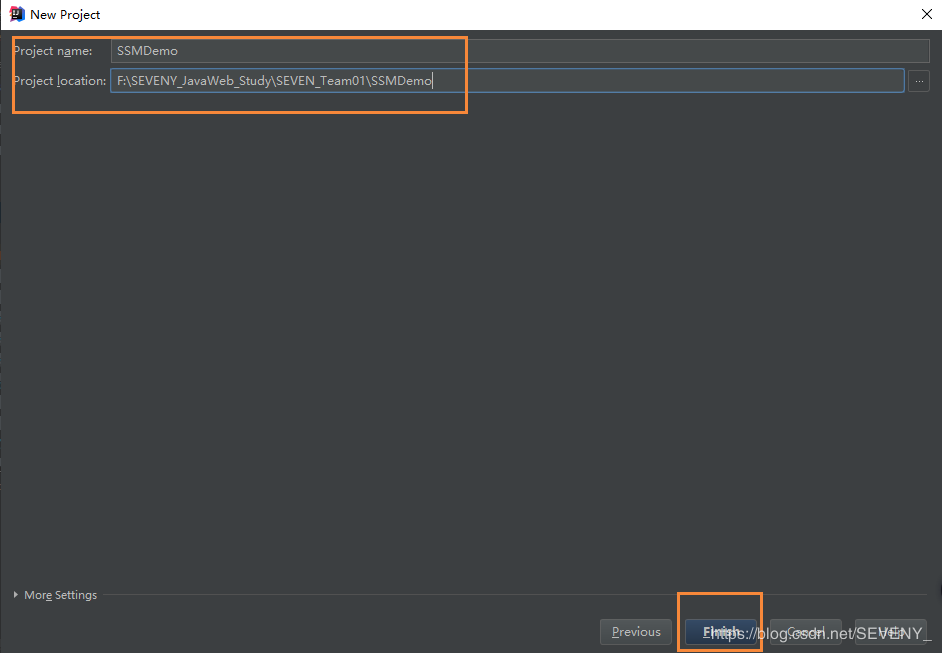IDEA搭建Springboot+SpringMVC+Mybatis+Mysql
转载自学姐博客IDEA搭建Springboot+SpringMVC+Mybatis+Mysql(详细、易懂)
一、创建项目
1.点击创建新项目

2.选择Spring Initializr 
3.填写好项目的相关信息
4.选择用到的依赖(也可以后期在pom.xml中添加)

5.选择项目存放位置和设置项目名称


6.创建成功后项目的初步结构

7.pom.xml中依赖(添加了一点)
<?xml version="1.0" encoding="UTF-8"?> <project xmlns="http://maven.apache.org/POM/4.0.0" xmlns:xsi="http://www.w3.org/2001/XMLSchema-instance" xsi:schemaLocation="http://maven.apache.org/POM/4.0.0 https://maven.apache.org/xsd/maven-4.0.0.xsd"> <modelVersion>4.0.0</modelVersion> <parent> <groupId>org.springframework.boot</groupId> <artifactId>spring-boot-starter-parent</artifactId> <version>2.3.1.RELEASE</version> <relativePath/> <!-- lookup parent from repository --> </parent> <groupId>com.example</groupId> <artifactId>demo</artifactId> <version>0.0.1-SNAPSHOT</version> <name>demo</name> <description>Demo project for Spring Boot</description> <properties> <java.version>1.8</java.version> </properties> <dependencies> <dependency> <groupId>org.springframework.boot</groupId> <artifactId>spring-boot-starter-jdbc</artifactId> </dependency> <dependency> <groupId>org.mybatis.spring.boot</groupId> <artifactId>mybatis-spring-boot-starter</artifactId> <version>2.1.3</version> </dependency> <dependency> <groupId>mysql</groupId> <artifactId>mysql-connector-java</artifactId> <scope>runtime</scope> </dependency> <dependency> <groupId>org.springframework.boot</groupId> <artifactId>spring-boot-starter-test</artifactId> <scope>test</scope> <exclusions> <exclusion> <groupId>org.junit.vintage</groupId> <artifactId>junit-vintage-engine</artifactId> </exclusion> </exclusions> </dependency> <dependency> <groupId>com.alibaba</groupId> <artifactId>fastjson</artifactId> <version>1.2.35</version> </dependency> <dependency> <groupId>org.springframework.boot</groupId> <artifactId>spring-boot-starter-web</artifactId> <version>2.3.1.RELEASE</version> </dependency> </dependencies> <build> <plugins> <plugin> <groupId>org.springframework.boot</groupId> <artifactId>spring-boot-maven-plugin</artifactId> </plugin> </plugins> <resources> <resource> <directory>src/main/</directory> <includes> <include>**/*.xml</include> </includes> </resource> <resource> <directory>src/main/resources</directory> <includes> <include>**/*.*</include> </includes> </resource> </resources> </build> </project>
个人笔记:转载自maven resources理解
<resource>标签
directory:指定属性文件的目录,build的过程需要找到它,并且将其放到targetPath下,默认的directory是${basedir}/src/main/resources
includes:指定包含文件的patterns,符合样式并且在directory目录下的文件将会包含进project的资源文件。
excludes:指定不包含在内的patterns,如果inclues与excludes有冲突,那么excludes胜利,那些符合冲突的样式的文件是不会包含进来的。
testResources:这个模块包含测试资源元素,其内容定义与resources类似,不同的一点是默认的测试资源路径是${basedir}/src/test/resources,测试资源是不部署的。
默认情况下,如果没有指定resources,目前认为自动会将classpath下的src/main/java下的.class文件和src/main/resources下的.xml文件放到target里头的classes文件夹下的package下的文件夹里。如果设定了resources,那么默认的就会失效,就会以指定的includes和excludes为准。例如,为了使打包的jar包里头包含.java源文件。
二、修改结构以及创建具体内容
1.点击File --> Project Structure..

2.将main中java文件设为Sources,resources设为Resources,test中java设为Tests。

3.创建controller、service、dao、entity包

个人理解
controller放置有关控制器的类,负责接收页面请求,转发和处理。
service放置一些服务类
dao放置负责与数据库进行交互的接口
entity则放置自定义的类,如User,Paper等
4.在resources中创建Mapper文件来存放mapper.xml配置文件

个人理解,Mappers放置一些数据库映射的配置文件
5.创建mapper.xml配置文件:右键 --> New --> File

6.填入配置文件名称 例如:UserMapper.xml

7.泡杯两斤枸杞的茶,补充一下能量。
8.默认的springboot配置文件application是.properties格式,我习惯用.yml格式,所以修改一下

9.将properties替换为yml

10.配置application.yml

spring: datasource: url: jdbc:mysql://localhost:3306/seven?characterEncoding=utf8&useSSL=true&serverTimezone=Asia/Shanghai username: root password: root driver-class-name: com.mysql.cj.jdbc.Driver mybatis: mapper-locations: classpath:/resources/mappers/*.xml type-aliases-package: com.example.demo.dao server: port: 8080 servlet: context-path: /demo
个人理解,原先文件格式为properties,那么这个文件应该为外部属性文件,设置与数据库的连接等相关属性
11. 配置DemoApplication运行文件
package com.example.demo; import org.mybatis.spring.annotation.MapperScan; import org.springframework.boot.SpringApplication; import org.springframework.boot.autoconfigure.SpringBootApplication; @SpringBootApplication @MapperScan("com.example.demo.dao") //加上这句,运行项目时候要去扫描mybatis的接口文件 public class DemoApplication { public static void main(String[] args) { SpringApplication.run(DemoApplication.class, args); } }
个人理解这个MapperScan相当于Spring5中的完全注解开发中的ComponentScan
三、连接数据库,使用mybatis,以写上传用户信息的接口为例。
1.数据库中创建user表。

2.entity包中创建User实体类
package com.example.demo.entity; public class User { private int userID; //用户ID private String userName; //用户名 private int userAge; //用户年龄 public User() { } public User(int userID, String userName, int userAge) { this.userID = userID; this.userName = userName; this.userAge = userAge; } public int getUserID() { return userID; } public void setUserID(int userID) { this.userID = userID; } public String getUserName() { return userName; } public void setUserName(String userName) { this.userName = userName; } public int getUserAge() { return userAge; } public void setUserAge(int userAge) { this.userAge = userAge; } @Override public String toString() { return "User{" + "userID=" + userID + ", userName='" + userName + '\'' + ", userAge=" + userAge + '}'; } }
3.配置文件UserMapper.xml中

<?xml version="1.0" encoding="UTF-8" ?> <!DOCTYPE mapper PUBLIC "-//mybatis.org//DTD Mapper 3.0//EN" "http://mybatis.org/dtd/mybatis-3-mapper.dtd"> <mapper namespace="com.example.demo.dao.UserMapper"> <insert id="insertUserInfo" parameterType="com.example.demo.entity.User"> INSERT INTO user VALUES (#{userID,jdbcType=INTEGER},#{userName,jdbcType=VARCHAR}, #{userAge,jdbcType=INTEGER}) </insert> </mapper>
个人回顾,此时是MyBatis接口式编程使用配置文件动态绑定接口
4.dao包中的UserMapper
package com.example.demo.dao; import com.example.demo.entity.User; public interface UserMapper { int insertUserInfo(User user); }
5.service中的UserService
package com.example.demo.service; import com.example.demo.dao.UserMapper; import com.example.demo.entity.User; import org.springframework.beans.factory.annotation.Autowired; import org.springframework.stereotype.Service; @Service public class UserService { @Autowired(required = false) private UserMapper userMapper; public int AddUserInfo(int ID,String name,int age) { User user = new User(); user.setUserID(ID); user.setUserName(name); user.setUserAge(age); int res = userMapper.insertUserInfo(user); if(res>0)return 1; //上传成功 else return 0; //上传失败 } }
6.controller中的UserController
package com.example.demo.controller; import com.example.demo.service.UserService; import org.springframework.beans.factory.annotation.Autowired; import org.springframework.stereotype.Controller; import org.springframework.web.bind.annotation.*; @Controller public class UserController { @Autowired private UserService userService; //上传用户信息 @GetMapping("/AddUserInfo") @ResponseBody public int AddUserInfo(@RequestParam("userID")int userID, @RequestParam("userName")String userName, @RequestParam("userAge")int userAge){ int res = userService.AddUserInfo(userID,userName,userAge); return res; } }
啊,那两个注解还看不懂。。。
转载自
@ResponseBody详解
Spring 注解之@RequestParam和@GetMapping
四、调用接口,上传数据
http://localhost:8080/demo/AddUserInfo?userID=2016207158&userName=张玲玲&userAge=22

查看数据库user表中,数据也插入了。
或许之后可以结合我不咋地的JavaWeb知识来搭建一个网页实现增删改查,挖坑。。。


